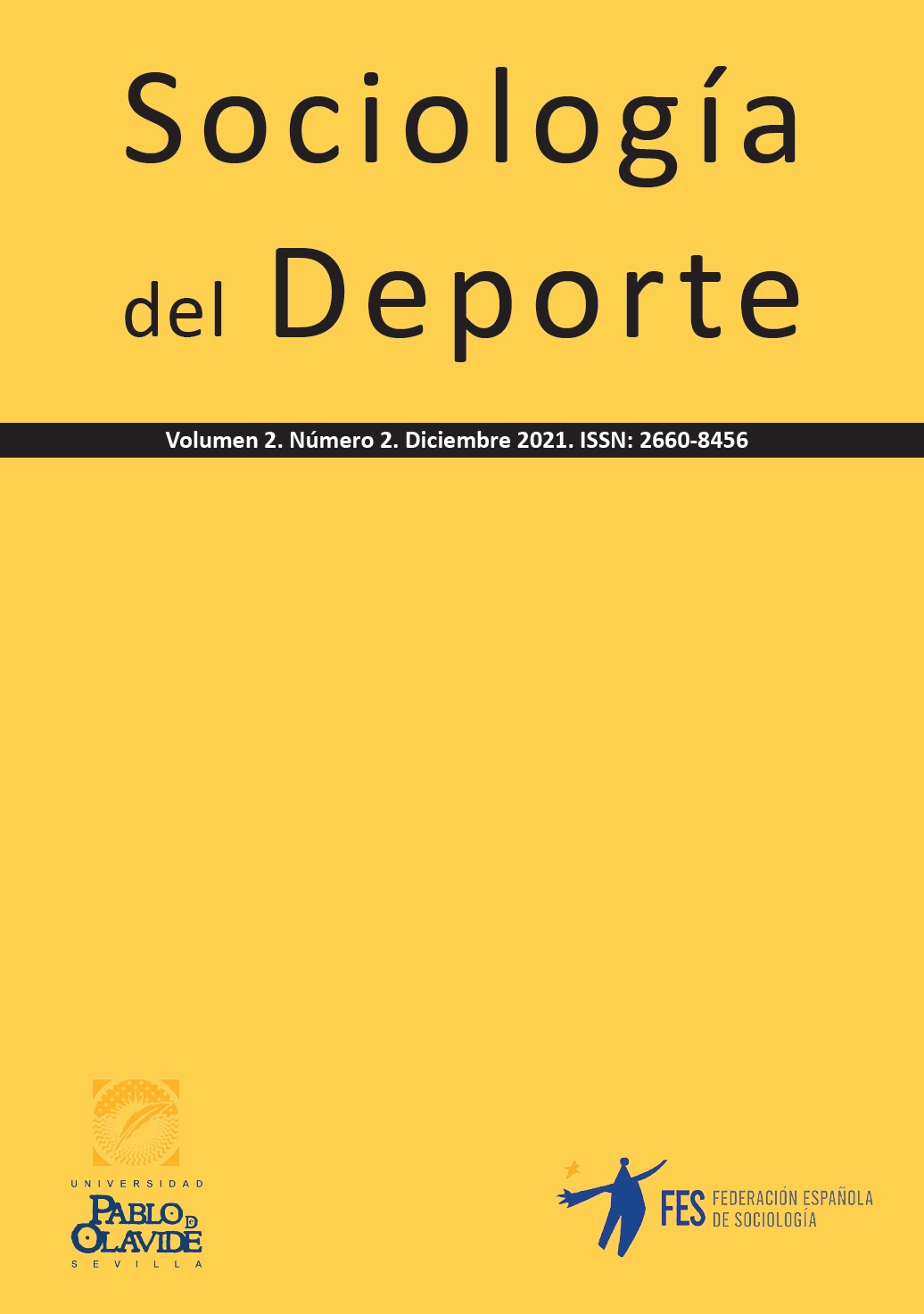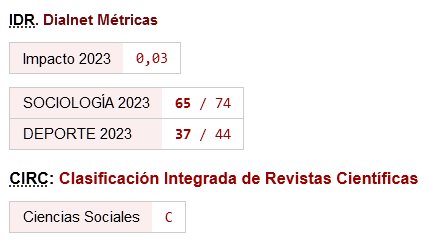La barrera de la testosterona en el deporte
DOI:
https://doi.org/10.46661/socioldeporte.6267Palabras clave:
Hiperandrogenismo, Semenya, Categorías deportivas, DSD, Proceso SociológicoResumen
World Athletics (anteriormente conocido como IAAF) ha publicado recientemente las normas de elegibilidad para la clasificación femenina que se aplican a las pruebas de carrera desde 400 metros hasta la milla. Esta normativa ha impedido que algunas atletas de élite con DSD (Diferencia de Desarrollo Sexual) compitan o que hayan tenido que variar su prueba preferida en los Juegos Olímpicos de Tokio 2020. Según World Athletics, el hiperandrogenismo femenino (una anomalía biológica que naturalmente produce un alto nivel de testosterona) debe ser "compensado" de alguna manera para respetar el juego limpio de la competencia. Sin embargo, tal argumento se basa en una suposición problemática: las mujeres hiperandrogénicas no son mujeres “naturales”, al menos cuando se trata de competir en deportes, por lo que su condición “anormal” debe arreglarse para cumplir con los estándares. La sociología procesual de Norbert Elias ayuda a situar el caso de las deportistas hiperandrogénicas dentro de un contexto más amplio de relaciones de poder. De esta manera, vemos que el caso se vuelve problemático porque estas mujeres deportistas son percibidas como una amenaza/disrupción de una de las categorías vertebrales del deporte: sexo/género. La barrera de la testosterona es para el sexo/género lo que la barrera del color fue para la raza en lo deportivo: una estrategia disciplinaria para mantener las que se consideran como categorías deportivas "naturales" en una época determinada.
Descargas
Citas
Bermon, Stepháne, and Pierre-Yves Garnier. 2017. “Serum androgen levels and their relation to performance in track and feld: mass spectrometry results from 2127 observations in male and female elite athletes.” British Journal Sports Med 51(17):1309-1314. https://doi.org/10.1136/bjsports-2017-097792
Bermon, Stepháne, and Pierre-Yves Garnier. 2021. “Correction: Serum androgen levels and their relation to performance in track and field: mass spectrometry results from 2127 observations in male and female elite athletes.”
British Journal of Sports Medicine 55:e7. https://doi.org/10.1136/bjsports-2017-097792corr1
Brenner, Steve.2021. “Interview. Caster Semenya”. The Guardian. April 23. https://www.theguardian.com/sport/2021/apr/23/caster-semenya-theyre-killing-sport-people-want-extraordinary-performances
Chodosh, Sara. 2019. “The complicated truth about testosterone’s effect on athletic performance.” Popular Science. November 20. https://www.popsci.com/story/science/testosterone-effect-athletic-performance/
Court of Arbitration for Sport (CAS). 2015. “CAS 2014/A/3759 Dutee Chand v. Athletics Federation of India (AFI) & The International Association of Athletics Federations (IAAF).” Lausanne: Court of Arbitration for Sport.
Duarte, Fernando. 2020. “Caster Semenya: 'Once I thought she was cheat. Now I'm sure she belongs in women's athletics'.” BBC. September 11. https://www.bbc.com/sport/africa/54116114
Eitzen, Stanley. 1989. “The Sociology of Amateur Sport: an Overview.” International Review for the Sociology of Sport 24 (2): 95-104.
Elias, Norbert. 2007. Involvement and detachment. Dublin: UCD.
Enriquez, Juan and Steve Gullans. 2012. “Genetically enhanced Olympics are coming.” Nature 487(7407): 297-297.
Foucault, Michel. 1977. Discipline and Punish. New York: Pantheon Books.
Gleeson, Michael. 2021. “Jamaican sprinter defends DSD athletes after Mboma takes silver.” The Sydney Morning Herald. August 3. https://www.smh.com.au/sport/athletics/banned-from-400m-mboma-takes-silver-in-200m-thompson-herah-gold-20210803-p58fll.html
Hoberman, John M. 1997. Darwin's athletes: How sport has damaged Black America and preserved the myth of race. Boston:Houghton Mifflin Harcourt.
Human Rights Watch. 2020. “They’re Chasing Us Away from Sport” Human Rights Violations in Sex Testing of Elite Women Athletes. https://www.hrw.org/sites/default/files/media_2020/12/lgbt_athletes1120_web.pdf
Ingle, Sean. 2021a. “IOC admits guidelines for transgender athletes are not fit for purpose.” The Guardian. July 30. https://www.theguardian.com/sport/2021/jul/30/ioc-admits-guidelines-for-transgender-athletes-are-not-fit-for-purpose
Ingle, Sean. 2021b. “Coe claims Mboma’s Tokyo 200m silver shows testosterone rules are working”. The Guardian. August 4. https://www.theguardian.com/sport/2021/aug/04/sebastian-coe-claims-chrstine-mboma-tokyo-olympics-200m-silver-medal-shows-testosterone-rules-are-working
IOC .2021. “Framework on Fairness, Inclusion and Non-discrimination on the basis of gender identity and sex variations.” November 16. https://stillmed.olympics.com/media/Documents/News/2021/11/IOC-Framework-Fairness-Inclusion-Non-discrimination-2021.pdf?_ga=2.166782846.1301260854.1638003295-829218953.1638003295
Karkazis, Katrina. 2009. Fixing Sex: Intersex, Medical Authority, and Lived Experience. Durham: Duke Univ.Press.
Muñoz Fernández, Eugenio. 2021. "Me gustaría pedir una prueba a fondo para saber que es una mujer." Marca. August 3. https://www.marca.com/juegos-olimpicos/atletismo/2021/08/03/61089b8622601d50398b4657.html?fbclid=IwAR2uzChl6_ZVIHyGuatpgcTKsU76s7JTkjjCBUYtcMyVUoXCYhFOjOp7gtE
Pape, Madelaine .2019. “Expertise and non-binary bodies: Sex, gender and the case of Dutee Chand.” Body & Society 25(4): 3-28.
Pielke Jr., Roger. 2017. “Sugar, spice and everything nice: how to end ‘sex testing’ in international athletics.” International Journal of Sports Policy and Politics 9(4):649–665.
Pielke Jr., Roger, Ross Tucker, and Erik Boye. 2019. “Scientific integrity and the IAAF testosterone regulations.” The International Sports Law Journal 19(1): 18-26.
Reuters Staff. 2019. “Athletics: Radcliffe warns Semenya verdict could be death of women's sport.” Reuters. April 19. https://www.reuters.com/article/us-athletics-semenya-radcliffe-idUSKCN1RV0RM
Sánchez-García, Raúl. 2020. Las cuatro heridas del deporte moderno. Jaen: Piedra Papel.
Siegelbaum, Lewis H. and Sasu Siegelbaum. 2017. “Class and Sport.” In The Oxford Handbook of Sports History, edited by Robert Edelman y Wayne Wilson, 429-43.Oxford University Press.
Sönksen, Peter H., Richard I. Holt, Walailuk Böhning, Nishan Guha,David A. Cowan, Christiaan Bartlett, and Danmark. 2018. “Why do endocrine profiles in elite athletes differ between sports?” Clinical diabetes and endocrinology 4(1):1-16.
Swartz, Leslie and Brian Watermeyer. 2008. “Cyborg anxiety: Oscar Pistorius and the boundaries of what it means to be human.” Disability & Society, 23(2):187-190.
Teetzel, Sarah.2006. "On transgendered athletes, fairness and doping: An international challenge." Sport in Society 9(2): 227-251.
World Athletics. 2011. “IAAF to introduce eligibility rules for females with hyperandrogenism.” April 12. https://www.worldathletics.org/news/iaaf-news/iaaf-to-introduce-eligibility-rules-for-femal-1
World Athletics. 2018. “IAAF introduces new eligibility regulations for female classification.” World Athetics. April 26. https://www.worldathletics.org/news/press-release/eligibility-regulations-for-female-classifica
World Athletics. 2019. “Eligibility Regulations for the Female Classification
(Athletes with Differences in Sex Development).” 1 November. https://www.worldathletics.org/search/?q=the+eligibility+regulations+for+female+classification

Descargas
Publicado
Cómo citar
Número
Sección
Licencia
Derechos de autor 2022 Raúl Sánchez García

Esta obra está bajo una licencia internacional Creative Commons Atribución-NoComercial-CompartirIgual 4.0.








